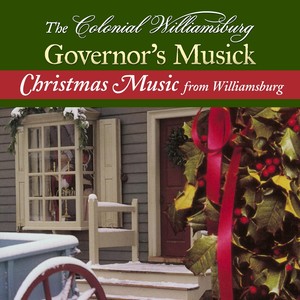
Christmas Music from Williamsburg
- 歌唱: The Colonial Williamsburg Governor's Musick
- 发行时间:2014-11-11
- 类型:录音室专辑
- 歌曲
- 时长
-
作曲家:Claude-Benigne Balbastre
-
作品集:Three Organ Noels
-
作曲家:Traditional
-
作品集:Greensleeves( 传统民歌《绿袖子》)
-
作曲家:Traditional
-
作品集:Music for a Ball
-
作曲家:Charles Theodore Pachelbel
-
作品集:Music for a Ball
-
作曲家:Traditional
-
作品集:Music for a Ball
-
作曲家:Arcangelo Corelli
-
作品集:Trio Sonata in B-Flat Major, Op. 4, No. 9
-
作曲家:Charles Theodore Pachelbel
-
作品集:Magnificat
-
作曲家:Traditional
-
作品集:Three English Carols
-
作曲家:Domenico Scarlatti
-
作曲家:Traditional
-
作曲家:William Croft
简介
Few descriptions of Christmas activities in colonial Virginia survive. Statements such as these indicate a joyful state of mind and are valuable testimony of celebration, at least among the well-to-do citizens. Christmas was generally celebrated at home with family and the seasonal excitement was centered there. The plantation mistress would have provided a festive dinner, and the working man enjoyed a special meat, or, if lucky, wild turkey, that stealthiest of fowl. On a rainy Christmas in 1709, William Byrd II of Westover plantation went to church, dined on roast beef, walked about the property, and was “merry with nonsense” in the evening. Many times country families could not even get to church although father or mother would certainly have read the nativity story from the King James Bible. Friends might have gathered on plantations to prance to the music of a country fiddler under the watchful eye of a traveling dancing master, while in Williamsburg the royal governor might have hosted a grand ball for the gentry at his sumptuously appointed Palace. The “Christmas guns” were fired to announce the day and occasionally in Williamsburg there were Christmas fireworks. Alexander Purdie’s Virginia Almanack of 1766 printed this verse to set the scene: Now Christmas comes, ‘tis fit that we Should feast and sing, and merry be Keep open house, let fiddlers play A fig for cold, sing care away. Curiously, references to colonial Christmas music occur rarely. Carol singing is not an annotated historical activity. Carols, like all true folk music, traveled across the seas as part of the cultural heritage from England. Many colonists were able musicians, among them Thomas Jefferson, John Randolph, and Judge Tyler, who might have played chamber music with Peter Pelham, the respected organist of Bruton Church. Philip Fithian, tutor to the children of the wealthy Robert Carter family at Nomini Hall, noted in his diary that on Christmas 1773 during supper Mr. Carter played his fortepiano for the family’s entertainment. A metrical psalm might have been sung by those able to attend church services. Since there was no formal choir in Williamsburg, it would have taken the skill of actors to have performed anthems. Pelham did know such musicians since he occasionally conducted ballad opera at the theater. The music recorded here has been gathered from a wide variety of sources. Its relatively simple character makes it suitable for performing by amateurs at home, for many people the most popular setting in which to enjoy Christmas music. A popular eighteenth-century English carol sums up such a Christmas: God bless the ruler of this House, And send him long to reign, And many a merry Christmas May live to see again. Among your friends and kindred, That live both far and near, And God send you a happy new Year. MUSIC NOTES- INSTRUMENTAL Three Organ Noels by Claude-Benigne Balbastre. Thomas Jefferson took his daughters Patsy and Polly with him to Paris where they studied with Balbastre, one of the leading keyboard players of the city. His gallante variations on old French carols show off typical organ registers, flutes, cromorne, trumpet, comet, and others. Works by Balbastre survive today in collections of Jefferson’s music. Divisions on Greensleeves. Improvising and composing variations, called divisions in England, were common musical practices. This set, included in The Division Flute, a popular anthology, has been further embellished in eighteenth-century style. Music for a Ball. A grand march, here a melody associated with King William III for whom Williamsburg was named, often began colonial dancing. The guest of honor or a solo couple of special ability might have performed the first minuet. Charles Theodore Pachelbel, the first important colonial musician, composed the “Bass Minuet,” which is preserved in Philadelphia. He worked in New England and Charleston where he taught Peter Pelham. The whole assembly danced succeeding reels, and country jigs concluded the festivities. The “Regatta Minuet” and “Congo” both come from the Bolling family manuscript music books. Trio Sonata in B-flat Major, Op. 4, No. 9, by Arcangelo Corelli. Originally written for two violins and continuo, this delightful chamber work is performed with a soprano recorder replacing the first violin. Infectious dance movements, corrente and gavotte, characterize this music, which was owned and played by Jefferson and his friends. MUSIC NOTES – VOCAL Magnificat by Charles Theodore Pachelbel. Pachelbel’s brilliant setting of the canticle of Mary from the first chapter of St. Luke’s Gospel survives only in German. The double chorus scoring and the Latin text would have limited performances in colonial America. One speculates what other music, presently unknown, may have come from this composer’s pen. Three English Carols. The absence of recorded carol singing in colonial Virginia is inexplicable. In view of the long history of this popular activity in the Old World, a custom going back for centuries, one feels that it probably happened as a matter of course, something too ordinary for general discussion. We know that “Greensleeves” was known in Virginia through its inclusion in The Beggar’s Opera and the New Year’s text dates from the seventeenth century. The poem “To Drive the Cold Winter Away” is found in Pills to Purge Melancholy, a popular verse anthology in colonial libraries. Many such lyrics were intended to be sung “God Rest ye Merry, Gentlemen” has been called the best-known carol in eighteenth-century London. Surely it emigrated to tidewater Virginia with the hundreds of other folk melodies that comprise our song tradition. These carols appear to be among the most likely pieces enjoyed in Yuletide celebrations. Sonata in C Major, K. 513, for harpsichord, by Domenico Scarlatti. The middle section of this composition quotes a popular Italian Christmas song, probably of folk origin. While Shepherds Watched their Flocks by Night. Tate and Brady’s hymn by the translators of the New Version of the Psalter was beyond doubt the best-known Christmas poem in the colonies. The arrangement here by James S. Darling demonstrates four customary ways of congregation singing: lining out between the parish clerk and the people, melody in the tenor, melody in the soprano, and with organ interludes in the manner of John Blow and Daniel Purcell. The hymn tune “Winchester Old” has long been associated with the poem although other melodies could have been used. CREDITS Three Organ Noels James S. Darling, organ Divisions on “Greensleeves” Herbert Watson, alto recorder John Barrows, viola da gamba Music for a Ball Annie Loud, violin Thomas Marshall, harpsichord Trio Sonata in B-flat Major, Op. 4, No. 9 Herbert Watson, soprano recorder Annie Loud, violin John Barrows, viola de gamba Thomas Marshall, harpsichord Magnificat (My Soul doth Magnify the Lord) The Bruton Parish Choir Marion Wilson, soprano Mary Deppe, soprano Beverly Kelly, alto Ryan Fletcher, baritone Herbert Deppe, bass Thomas Marshall, organ James S. Darling, director Three English Carols Ryan Fletcher, baritone James S. Darling, harpsichord Sonata in C Major, K. 513 Thomas Marshall, harpsichord While Shepherds Watched their Flocks by Night The Bruton Parish Choir Ryan Fletcher, baritone Thomas Marshall, organ James S. Darling, director O be Joyful in the Lord, All ye Lands The Bruton Parish Choir Mary Deppe, soprano Beverly Kelly, alto Ryan Fletcher, baritone Herbert Deppe, bass Thomas Marshall, organ James S. Darling, director PROGRAM Three Organ Noels Claude-Benigne Balbastre (1727-1799) [1] Prelude [2] A la Venue de Noel (At the coming of Christmas) [3] Au jo deu de pubelle (Today We Sing the Virgin Birth) [4] Joseph est bien Marie (Joseph has Found a Wife) [5] Divisions on Greensleeves Anonymous Music for a Ball [6] King William’s March Anonymous [7] Bass Minuet Charles Theodore Pachelbel (1690-1750) [8] Regatta Minuet Anonymous [9] Congo Anonymous [10] Trio Sonata in B-flat Major, Arcangelo Corelli Op. 4, No. 9 (1653-1713) Preludio, Corrente, Grave, Tempo di Gavotta [11] Magnificat Charles Theodore Pachelbel (My Soul doth Magnify the Lord) Three English Carols [12] God Rest ye Merry, Gentlemen [13] The Old Year now away is Fled (Greensleeves) [14] To Drive the Cold Winter Away [15] Sonata in C Major, K. 513 Domenico Scarlatti (1685-1757) [16] While Shepherds Watched Traditional Their Flocks by Night [17] O be Joyful in the Lord, All ye Lands William Croft (1678-1727) The recording was made in Bruton Parish Church, Williamsburg, Virginia. AEolian-Skinner organ designed by G. Donald Harrison, 1955, with tonal revisions by Kinzey and Angerstein, 1978. Harpsichord by William Dowd, 1968. All income from the sales of this recording is used for the purposes of The Colonial Williamsburg Foundation, which operates the Historic Area of Williamsburg, and to carry forward its educational programs. Colonial Williamsburg also welcomes tax-deductible contributions. Friends interested in discussing gifts to the Foundation are asked to write the President, The Colonial Williamsburg Foundation. P.O. Box 1776, Williamsburg, Virginia 23187-1776. Recording Engineer Richard B. Tisdale, Jr. Notes J.S. Darling ©1981 by The Colonial Williamsburg Foundation







